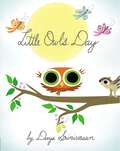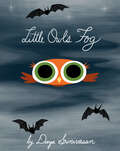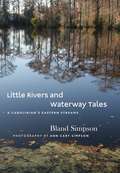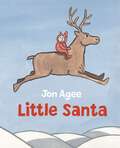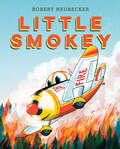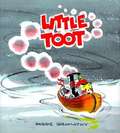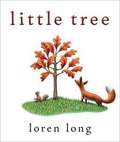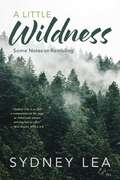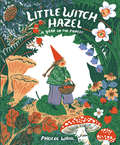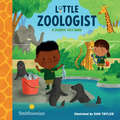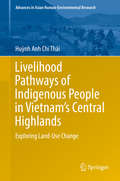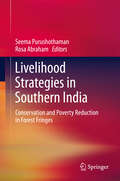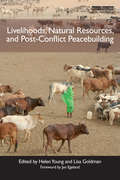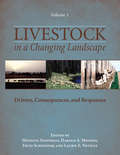- Table View
- List View
Little Owl's Day (Little Owl)
by Divya SrinivasanChikit-chikit-chik!A squirrel is chittering. Bees are buzzing. The sun is high in the sky. And Little Owl is supposed to be asleep, but when he wakes up early, he’s just too curious to close his eyes again. The forest he knows so well at nighttime is completely different – and exciting – in the day! After watching butterflies dance, wolf pups play, and then his very first rainbow, Little Owl returns to his tree. He has many new stories for his mama.A blue sky companion to Little Owl’s Night, Little Owl’s Day is just right for young children and the perfect introduction to the joy and wonder of the natural world.
Little Owl's Fog (Little Owl)
by Divya SrinivasanLittle Owl braves the unknown in this book that's just perfect for Halloween!The bats have invited Little Owl to visit their cavern! He&’s never been to that part of the forest and feels a shiver of excitement at the thought. But when Skunk reveals that he once saw something strange near the cavern, Little Owl worries about what he might find on the way. Good thing he&’ll have his friend Raccoon by his side!As they make their way, fog comes tumbling down the mountains. Veiled in mist, even the usual places look mysterious. But that turns out to be half the fun.In his beloved night forest, where good friends are never too far away, Little Owl discovers that strange can also be WONDERFUL!
Little Owl's Love (Little Owl)
by Divya SrinivasanThe star of Little Owl's Night returns to find love in his beloved nighttime forest."What do I love" Little Owl thought.There were so many things.Gliding along on a quiet night, Little Owl looks for the things that make him happy--shimmering stars, winking fireflies, listening to the cricket song,and most of all, spending time with his good friends.Lyrical and deeply heartfelt, Little Owl's Love is a love letter to the natural world on a child's level.
Little Owl's Night (Little Owl)
by Divya SrinivasanIt's evening in the forest and Little Owl wakes up from his day-long sleep to watch his friends enjoying the night. Hedgehog sniffs for mushrooms, Skunk nibbles at berries, Frog croaks, and Cricket sings. A full moon rises and Little Owl can't understand why anyone would want to miss it. Could the daytime be nearly as wonderful? Mama Owl begins to describe it to him, but as the sun comes up, Little Owl falls fast asleep.Putting a twist on the bedtime book, Little Owl's Night is sure to comfort any child with a curiosity about the night.
Little Owl's Snow (Little Owl)
by Divya SrinivasanLittle Owl experiences his first snow and first winter in this perfect follow-up to Little Owl's Night and Little Owl's Day!"Winter's almost here!" says Little Owl, as he observes leaves falling, animal friends hibernating, and a chill from his feathers to his feet. And just as he and his friend racoon are watching their breath make fog in the cold air, it happens: Snow! Here is the perfect follow-up to Little Owl's Night and Little Owl's Day, and a wonderful introduction to the changing of the seasons!
Little Penguins
by Cynthia RylantNewbery Medal–winning author Cynthia Rylant and Caldecott Honor-winning, bestselling illustrator Christian Robinson pair up to tell this wintry story about five little penguins enjoying a snowy day. Snowflakes? Many snowflakes. Winter is coming. So begins this ever-so-simple story. As the snow starts to fall, the excited penguins pull out scarves, mittens, heavy socks, and boots, and Mama helps them bundle up. But when it&’s time to go out, one timid penguin decides to stay home. Filled with waddling baby penguins, playful text, and delightful illustrations, this book feels like a young picture-book classic in the making."Visually stunning. . . . Pair with Ezra Jack Keats&’s classic The Snowy Day." —Booklist, Starred"An excellent tale for the very young. A very warm and satisfying bedtime book and a paean to penguins and winter delights." —Kirkus ReviewsWinners of the National Parenting Product AwardA School Library Journal Best Book of the Year
Little Rivers and Waterway Tales
by Bland Simpson Ann Cary SimpsonBland Simpson regales us with new tales of coastal North Carolina's "water-loving land," revealing how its creeks, streams, and rivers shape the region's geography as well as its culture. Drawing on deep family ties and coastal travels, Simpson and wife and collaborator Ann Cary Simpson tell the stories of those who have lived and worked in this country, chronicling both a distinct environment and a way of life. Whether rhapsodizing about learning to sail on the Pasquotank River or eating oysters on Ocracoke, he introduces readers to the people and communities along the watery web of myriad "little rivers" that define North Carolina's sound country as it meets the Atlantic.With nearly sixty of Ann Simpson's photographs, Little Rivers joins the Simpsons' two previous works, Into the Sound Country and The Inner Islands, in offering a rich narrative and visual document of eastern North Carolina's particular beauty. Urging readers to take note of the poetry in "every rivulet and rill, every creek, crick, branch, run, stream, prong, fork, river, pocosin, swamp, basin, estuary, cove, bay, and sound," the Simpsons show how the coastal plain's river systems are in many ways the region's heart and soul.
Little Santa
by Jon AgeeEver wonder what Santa was like as a child? Award-winning author/illustrator Jon Agee brings us the funny, playful answer in this Christmas picture book destined to become a classic.Little Santa loves the North Pole. The rest of his family? Not so much. So, when they decide to move to Florida, Santa is miserable. Lucky for him, a blizzard foils their plans. The only way out of the house is up the chimney. Up goes Santa, to look for help, and along the way, he meets a reindeer and a large group of elves, who are more than eager to join in the rescue! With the sly humor of Jon Klassen and the read-aloud pleasure of How the Grinch Stole Christmas, this tale of Santa’s beginnings is perfect for every kid’s holiday library.
Little Seasons: Autumn Leaves (Little Seasons)
by Mirka HokkanenDiscover the incredible journey of leaves each season and their essential role in nature! As winter fades into spring, the big job of leaves begins—unfurling from buds and stretching out to soak up the sun. From delicate maple leaves to the large fronds of ferns and everything in between, learn what leaves can do in this pitch-perfect picture book for young readers. With clear, informative text and bright, charming illustrations, along with amusing interjections from the leaves themselves, this is an exciting addition to the LITTLE SEASONS picture book series exploring natural life cycles!
Little Seasons: Spring Seeds (Little Seasons)
by Mirka HokkanenA funny and informative nonfiction picture book introducing the life cycle of seeds and exploring the season of spring, including interactive back matter.Discover how seeds spring into action! As winter warms into spring, the amazing life cycle begins—seeds root and sprout and start to grow. From tiny carrot seeds to big avocado seeds and everything in between, discover what seeds can do in this pitch-perfect picture book for younger readers. With clear, informative text and bright, charming illustrations, as well as lots of hilarious interjections from the seeds themselves, this is an exciting start to a new nonficton picture book series exploring life cycles and the seasons.
Little Smokey
by Robert NeubeckerFor a brave firefighting airplane, the sky's the limit! This timeless story of teamwork and determination is perfect for kids who loved The Little Engine That Could and shows how even unlikely heroes can help their community in times of need.When forest fires blaze, the airplanes at Nif-C spring into action! Some swoop low to spray water on the flames. Others drop bright red fire retardant. Little Smokey hasn't quite figured out her job yet, but she wants to help. . . . And when a fire like no other flares up--a fire that none of the other planes can control--it's Smokey's turn to show what she's made of.Featuring useful information about wildfires and fire prevention in the back of the book, Little Smokey is a must-have for children growing up in a world where climate change makes natural disasters a common occurrence. Parents looking to teach their kids about how fires spread and what they can do about it will surely want to take flight with Little Smokey. "Positively cinematic. . . . this book may look like a classic, but with forest fires ever more frequent and intense, it's truly timely." --Kirkus
Little Toot
by Hardie GramatkyIn this Weekly Reader Children's Book Club selection, a tiny tug rescues a big ship.
Little Tree
by Loren Long<p>In the middle of a little forest, there lives a Little Tree who loves his life and the splendid leaves that keep him cool in the heat of long summer days. Life is perfect just the way it is. <p>Autumn arrives, and with it the cool winds that ruffle Little Tree's leaves. One by one the other trees drop their leaves, facing the cold of winter head on. But not Little Tree—he hugs his leaves as tightly as he can. Year after year Little Tree remains unchanged, despite words of encouragement from a squirrel, a fawn, and a fox, his leaves having long since turned brown and withered. As Little Tree sits in the shadow of the other trees, now grown sturdy and tall as though to touch the sun, he remembers when they were all the same size. And he knows he has an important decision to make. <p>From #1 New York Times bestselling author Loren Long comes a gorgeously-illustrated story that challenges each of us to have the courage to let go and to reach for the sun.
Little Tree
by Loren LongFor graduates, for their parents, for anyone facing change, here is a gorgeously illustrated and stunningly heartfelt ode to the challenges of growing up and letting go. A story of the seasons and stepping stones as poignant for parents as for their kids, from the creator of Otis the tractor and illustrator of Love by Matt de la Pena."Long&’s gentle but powerful story about a young tree who holds tight to his leaves, even as everyone else lets theirs drop, takes on nothing less than the pain and sorrow of growing up. . . . As in Long&’s unaccountably profound books about Otis the tractor, a pure white background somehow adds to the depth."—The New York Times Book Review In the middle of a little forest, there lives a Little Tree who loves his life and the splendid leaves that keep him cool in the heat of long summer days. Life is perfect just the way it is. Autumn arrives, and with it the cool winds that ruffle Little Tree's leaves. One by one the other trees drop their leaves, facing the cold of winter head on. But not Little Tree—he hugs his leaves as tightly as he can. Year after year Little Tree remains unchanged, despite words of encouragement from a squirrel, a fawn, and a fox, his leaves having long since turned brown and withered. As Little Tree sits in the shadow of the other trees, now grown sturdy and tall as though to touch the sun, he remembers when they were all the same size. And he knows he has an important decision to make.From #1 New York Times bestselling Loren Long comes a gorgeously-illustrated story that challenges each of us to have the courage to let go and to reach for the sun.Praise for Little Tree* "The illustrations are beautifully rendered . . . Understated and inviting, young readers will be entranced by Little Tree&’s difficult but ultimately rewarding journey."—Booklist, starred review"Long&’s gentle but powerful story about a young tree who holds tight to his leaves, even as everyone else lets theirs drop, takes on nothing less than the pain and sorrow of growing up. Season after season, Little Tree clings to his brown-leaved self until he can take a leap and shed his protection. He feels &‘the harsh cold of winter,&’ but soon grows tall and green, and it&’s not bad at all. As in Long&’s unaccountably profound books about Otis the tractor, a pure white background somehow adds to the depth."—The New York Times Book Review* "[Long's] willingness to take his time and even test the audience&’s patience with his arboreal hero&’s intransigence results in an ending that&’s both a big relief and an authentic triumph. Long&’s earnest-eloquent narrative voice and distilled, single-plane drawings, both reminiscent of an allegorical pageant, acknowledge the reality of the struggle while offering the promise of brighter days ahead."—Publishers Weekly, starred review"Long is sparing with the text, keeping it simple and beautifully descriptive. Brilliantly colored illustrations done in acrylic, ink, and pencil stand out on bright white pages, with Little Tree taking the center position in each double-page spread. Tender and gentle and altogether lovely."—Kirkus Reviews"Children will see the tree facing the scariness of change; adult readers may well feel wistful as the story underscores the need to let their babies grow toward independence. Beautiful. Grade: A"—Cleveland Plain Dealer
Little Wildness: Some Notes on Rambling
by Sydney LeaWhat does a good long ramble in the woods tell us about our shared experiences, our loneliness. Is it possible to shed our civilized layers of defensive behavior, our fear of unmasking and discovery, of the unknown or once-known and forgotten? Join celebrated outdoorsman and poet Sydney Lea as he walks off into his beloved New England woods on a vision quest that touches everyone who reads along to keep him company. One's own shape-shifting powers come into focus in the light of Lea's surprising discoveries and revelations.
Little Witch Hazel: A Year in the Forest
by Phoebe WahlAn earthy and beautiful collection of four stories that celebrate the seasons, nature, and life, from award-winning author-illustrator Phoebe Wahl.Little Witch Hazel is a tiny witch who lives in the forest, helping creatures big and small. She's a midwife, an intrepid explorer, a hard worker and a kind friend. In this four-season volume, Little Witch Hazel rescues an orphaned egg, goes sailing on a raft, solves the mystery of a haunted stump and makes house calls to fellow forest dwellers. But when Little Witch Hazel needs help herself, will she get it in time?Little Witch Hazel is a beautiful ode to nature, friendship, wild things and the seasons that only Phoebe Wahl could create: an instant classic and a book that readers will pore over time and time again.
Little Zoologist (A Science Tots Book)
by Dan TaylorTeach your baby all about being a zoologist with this new board book published in partnership with Smithsonian.Scales. Notebooks. Habitats. Microscopes. Zoologists do a lot more than just feed and take care of animals and now young babies and toddlers will be able to learn all about what it means to be a zoologist and what tools they use as part of their job in this exciting and fun book in a new board book series published in conjunction with the Smithsonian Institute.
Live Sustainably Now: A Low-Carbon Vision of the Good Life
by Karl CoplanAny realistic response to climate change will require reducing carbon emissions to a sustainable level. Yet even people who already recognize that the climate is the most urgent issue facing the planet struggle to understand their individual responsibilities. Is it even possible to live with a sustainable carbon footprint in modern American society—much less to live well? What are the options for those who would like to make climate awareness part of their daily lives but don’t want to go off the grid or become a hermit?In Live Sustainably Now, Karl Coplan shares his personal journey of attempting to cut back on carbon without giving up the amenities of a suburban middle-class lifestyle. Coplan chronicles the joys and challenges of a year on a carbon budget—kayaking to work, hunting down electric-car charging stations, eating a Mediterranean-style diet, and enjoying plenty of travel on weekends and vacations while avoiding long-distance flights. He explains how to set a personal carbon cap and measure your actual footprint, with his own results detailed in monthly diary entries. Presenting the pros and cons of different energy, transportation, and lifestyle options, Live Sustainably Now shows that there does not have to be a trade-off between the ethical obligation to maintain a sustainable carbon footprint and the belief that life should be fulfilling and fun. This powerful and persuasive book provides an individual-level blueprint for a carbon-sustainable tweak to the American dream.
Livelihood Pathways of Indigenous People in Vietnam’s Central Highlands: Exploring Land-Use Change (Advances in Asian Human-Environmental Research)
by Huỳnh Anh Chi TháiThis study focuses on impacts of the environmental and socio-economic transformation on the indigenous people's livelihoods in Vietnam's Central Highlands recent decades since the country's reunification in 1975.The first empirical section sheds light on multiple external conditions (policy reforms, population trends, and market forces) exposed onto local people. The role of human and social capital is examined again in a specific livelihood of community-based tourism to testify the resilience level of local people when coping with constraints. The study concludes with an outlook on implications of development processed which still places agriculture at the primary position livelihood, and pays attention to human capital and social capital of indigenous groups in these highlands.
Livelihood Strategies in Southern India
by Seema Purushothaman Rosa AbrahamThis volume is a compilation of essays that focus on livelihood issues faced by forest communities of the southern Western Ghats region of India. Communities living along the fringes of forests are, more often than not, overlooked in academic and policy discussions. However, they face considerable pressures, being sandwiched between conservation endeavours and the forces of urbanization and commercialization. The chapters in this book provide an insight into the kinds of livelihood issues these communities face and the potential means that can be adopted to sustain these livelihoods. This volume provides a unique alternative perspective by locating livelihood issues within socio-ecological-economic narratives of communities living at the intersection of the three southern Indian states of Karnataka, Kerala and Tamil Nadu, and suggests directions for policies to address these challenges.
Livelihoods, Natural Resources, and Post-Conflict Peacebuilding (Post-Conflict Peacebuilding and Natural Resource Management)
by Helen Young Lisa GoldmanSustaining and strengthening local livelihoods is one of the most fundamental challenges faced by post-conflict countries. By degrading the natural resources that are essential to livelihoods and by significantly hindering access to those resources, conflict can wreak havoc on the ability of war-torn populations to survive and recover. This book explores how natural resource management initiatives in more than twenty countries and territories have supported livelihoods and facilitated post-conflict peacebuilding. Case studies and analyses identify lessons and opportunities for the more effective design of interventions to support the livelihoods that depend on natural resources – from land to agriculture, forestry, fisheries, and protected areas. The book also explores larger questions about how to structure livelihoods assistance as part of a coherent, integrated approach to post-conflict redevelopment. Livelihoods and Natural Resources in Post-Conflict Peacebuilding is part of a global initiative to identify and analyze lessons in post-conflict peacebuilding and natural resource management. The project has generated six books of case studies and analyses, with contributions from practitioners, policy makers, and researchers. Other books in this series address high value resources, land, water, assessing and restoring natural resources, and governance.
Lives of Weeds: Opportunism, Resistance, Folly
by John CardinaLives of Weeds explores the tangled history of weeds and their relationship to humans. Through eight interwoven stories, John Cardina offers a fresh perspective on how these tenacious plants came about, why they are both inevitable and essential, and how their ecological success is ensured by determined efforts to eradicate them. Linking botany, history, ecology, and evolutionary biology to the social dimensions of humanity's ancient struggle with feral flora, Cardina shows how weeds have shaped—and are shaped by—the way we live in the natural world. Weeds and attempts to control them drove nomads toward settled communities, encouraged social stratification, caused environmental disruptions, and have motivated the development of GMO crops. They have snared us in social inequality and economic instability, infested social norms of suburbia, caused rage in the American heartland, and played a part in perpetuating pesticide use worldwide. Lives of Weeds reveals how the technologies directed against weeds underlie ethical questions about agriculture and the environment, and leaves readers with a deeper understanding of how the weeds around us are entangled in our daily choices.
Lives of a Cell: Notes of a Biology Watcher
by Lewis ThomasElegant, suggestive, and clarifying, Lewis Thomas's profoundly humane vision explores the world around us and examines the complex interdependence of all things. Extending beyond the usual limitations of biological science and into a vast and wondrous world of hidden relationships, this provocative book explores in personal, poetic essays to topics such as computers, germs, language, music, death, insects, and medicine. Lewis Thomas writes, "Once you have become permanently startled, as I am, by the realization that we are a social species, you tend to keep an eye out for the pieces of evidence that this is, by and large, good for us."<P><P> Winner of the National Book Award
Livestock in a Changing Landscape, Volume 1: Drivers, Consequences, and Responses
by Harold A. Mooney Laurie E. Neville Henning Steinfeld Fritz SchneiderThe rapidly changing nature of animal production systems, especially increasing intensification and globalization, is playing out in complex ways around the world. Over the last century, livestock keeping evolved from a means of harnessing marginal resources to produce items for local consumption to a key component of global food chains. Livestock in a Changing Landscape offers a comprehensive examination of these important and far-reaching trends. The books are an outgrowth of a collaborative effort involving international nongovernmental organizations including the United Nations Food and Agriculture Organization (UN FAO), the International Livestock Research Institute (ILRI), the Swiss College of Agriculture (SHL), the French Agricultural Research Centre for International Development (CIRAD), and the Scientific Committee for Problems of the Environment (SCOPE). Volume 1 examines the forces shaping change in livestock production and management; the resulting impacts on landscapes, land use, and social systems; and potential policy and management responses. Volume 2 explores needs and draws experience from region-specific contexts and detailed case studies. The case studies describe how drivers and consequences of change play out in specific geographical areas, and how public and private responses are shaped and implemented. Together, the volumes present new, sustainable approaches to the challenges created by fundamental shifts in livestock management and production, and represent an essential resource for policy makers, industry managers, and academics involved with this issue.
Livestock in a Changing Landscape, Volume 2: Experiences and Regional Perspectives
by Harold A. Mooney Jeroen Dijkman Pierre Gerber Shirley Tarawali Cees De HaanThe rapidly changing nature of animal production systems, especially increasing intensification and globalization, is playing out in complex ways around the world. Over the last century, livestock keeping evolved from a means of harnessing marginal resources to produce items for local consumption to a key component of global food chains. Livestock in a Changing Landscape offers a comprehensive examination of these important and far-reaching trends. The books are an outgrowth of a collaborative effort involving international nongovernmental organizations including the United Nations Food and Agriculture Organization (UN FAO), the International Livestock Research Institute (ILRI), the Swiss College of Agriculture (SHL), the French Agricultural Research Centre for International Development (CIRAD), and the Scientific Committee for Problems of the Environment (SCOPE). Volume 1 examines the forces shaping change in livestock production and management; the resulting impacts on landscapes, land use, and social systems; and potential policy and management responses. Volume 2 explores needs and draws experience from region-specific contexts and detailed case studies. The case studies describe how drivers and consequences of change play out in specific geographical areas, and how public and private responses are shaped and implemented. Together, the volumes present new, sustainable approaches to the challenges created by fundamental shifts in livestock management and production, and represent an essential resource for policy makers, industry managers, and academics involved with this issue
